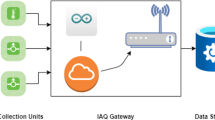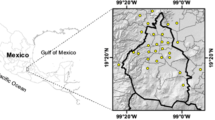Abstract
PM2.5 is an important air pollution index, which has been widely concerned. An excellent PM2.5 prediction system can effectively help people protect their respiratory tract from injury. However, due to the strong uncertainty of PM2.5 data, the accuracy of traditional point prediction and interval prediction method is not satisfactory, especially for interval prediction, which is usually difficult to achieve the expected interval coverage (PINC). In order to solve the above problems, a new hybrid PM2.5 prediction system is proposed, which can quantify the certainty and uncertainty of future PM2.5 at the same time. For point prediction, a multi-strategy improved multi-objective crystal algorithm (IMOCRY) is proposed; the chaotic mapping and screening operator are added to make the algorithm more suitable for practical application. At the same time, the combined neural network based on unconstrained weighting method further improves the point prediction accuracy. For interval prediction, a new strategy is proposed, which uses the combination of fuzzy information granulation and variational mode decomposition to process the data. The high-frequency components are extracted by the VMD method, and then quantified by FIG method. By this way, the fuzzy interval prediction results with high coverage and low interval width are obtained. Through 4 groups of experiments and 2 groups of discussions, the advanced nature, accuracy, generalization, and fuzzy prediction ability of the prediction system are all satisfactory, which verified the effect of the system in practical application.







Similar content being viewed by others
Data availability
The datasets generated during and/or analyzed during the current study are not publicly available due but are available from the corresponding author on reasonable request.
Abbreviations
- VMD :
-
Variational Mode Decomposition
- BP :
-
Back Propagation Neural Network
- Elman :
-
Elman Neural Network
- MOCRY :
-
Multi-objective Crystal Algorithm
- IMOCRY :
-
Improved Multi-objective Crystal Algorithm
- MSE :
-
Mean Square Error
- RMSE :
-
Root Mean Square Error
- AIS :
-
Average Interval Score
- ACE :
-
Average Coverage Error
- FIG :
-
Fuzzy Information Granulation
- LSTM :
-
Long Short-Term Memory
- MOSSA :
-
Multi-objective Sparrow Search Algorithm
- MOMVO :
-
Multi-objective Multi-verse Optimization
- MAPE :
-
Mean Absolute Percentage Error
- MAE :
-
Mean Absolute Error
- R 2 :
-
R-Square
- PICP :
-
PI Coverage Probability
- MPIW :
-
The Mean PI Width
References
Ahmadi B, Ceylan O, Ozdemir A (2021) A multi-objective optimization evaluation framework for integration of Distributed Energy Resources. J Energy Storage 41:103005. https://doi.org/10.1016/j.est.2021.103005
ArunKumar KE, Kalaga DV, Kumar CM, Kawaji M, Brenza TM (2021) Forecasting of COVID-19 using deep layer recurrent neural networks (RNNS) with gated recurrent units (grus) and long short-term memory (LSTM) cells. Chaos Solitons Fractals 146:110861. https://doi.org/10.1016/j.chaos.2021.110861
Bai L, Liu Z, Wang J (2022) Novel hybrid extreme learning machine and multi-objective optimization algorithm for Air Pollution Prediction. Appl Math Model 106:177–198. https://doi.org/10.1016/j.apm.2022.01.023
Bera B, Bhattacharjee S, Sengupta N, Saha S (2021) PM2.5 concentration prediction during COVID-19 lockdown over Kolkata Metropolitan City, India using MLR and ann models. Environ Challenges 4:100155. https://doi.org/10.1016/j.envc.2021.100155
Chu J, Dong Y, Han X, Xie J, Xu X, Xie G (2020) Short-term prediction of Urban PM2.5 based on a hybrid modified variational mode decomposition and support vector regression model. Environ Sci Pollut Res 28(1):56–72. https://doi.org/10.1007/s11356-020-11065-8
Cox LA (2023) Re-assessing human mortality risks attributed to PM2.5-mediated effects of agricultural ammonia. Environ Res 223:115311. https://doi.org/10.1016/j.envres.2023.115311
Demirbay B, Bayram Kara D, Uğur Ş (2022) Multivariate regression (MVR) and different artificial neural network (ANN) models developed for optical transparency of conductive polymer nanocomposite films. Expert Syst Appl 207:117937. https://doi.org/10.1016/j.eswa.2022.117937
Deng W, Li Y, Huang K, Wu D, Yang C, Gui W (2023) LSTMED: An uneven dynamic process monitoring method based on LSTM and Autoencoder Neural Network. Neural Netw 158:30–41. https://doi.org/10.1016/j.neunet.2022.11.001
Dong Y, Wang J, Wang R, Jiang H (2023) Accurate combination forecasting of wave energy based on multiobjective optimization and fuzzy information granulation. J Clean Prod 386:135772. https://doi.org/10.1016/j.jclepro.2022.135772
Guo X, Wang Y, Mei S, Shi C, Liu Y, Pan L, Li K, Zhang B, Wang J, Zhong Z, Dong M (2022) Monitoring and modelling of PM2.5 concentration at subway station construction vased on IOT and LSTM algorithm optimization. J Clean Prod 360:132179. https://doi.org/10.1016/j.jclepro.2022.132179
Han X, Dong J (2023) Applications of fractional gradient descent method with adaptive momentum in BP Neural Networks. Appl Math Comput 448:127944. https://doi.org/10.1016/j.amc.2023.127944
Hough I, Sarafian R, Shtein A, Zhou B, Lepeule J, Kloog I (2021) Gaussian Markov random fields improve ensemble predictions of daily 1 km PM2.5 and PM10 across France. Atmos Environ 264:118693. https://doi.org/10.1016/j.atmosenv.2021.118693
Hu S, Liu P, Qiao Y, Wang Q, Zhang Y, Yang Y (2022) PM2.5 concentration prediction based on WD-SA-LSTM-BP Model: a case study of nanjing city. Environ Sci Pollut Res 29(46):70323–70339. https://doi.org/10.1007/s11356-022-20744-7
Jiang F, Zhu Q, Yang J, Chen G, Tian T (2022) Clustering-based interval prediction of electric load using multi-objective Pathfinder algorithm and Elman Neural Network. Appl Soft Comput 129:109602. https://doi.org/10.1016/j.asoc.2022.109602
Kulkarni S, Simon SP, Sundareswaran K (2013) A spiking neural network (SNN) forecast engine for short-term electrical load forecasting. Appl Soft Comput 13(8):3628–3635. https://doi.org/10.1016/j.asoc.2013.04.007
Li B, Wang H (2022) Multi-objective sparrow search algorithm: a novel algorithm for solving complex multi-objective optimisation problems. Exp Syst Appl 210:118414. https://doi.org/10.1016/j.eswa.2022.118414
Li K, Huang W, Hu G, Li J (2023) Ultra-short term power load forecasting based on CEEMDAN-SE and LSTM neural network. Energy Build 279:112666. https://doi.org/10.1016/j.enbuild.2022.112666
Linh Thao NN, Pimonsree S, Prueksakorn K, Bich Thao PT, Vongruang P (2022) Public health and economic impact assessment of PM2.5 from open biomass burning over countries in mainland Southeast Asia during the smog episode. Atmos Pollut Res 13(6):101418. https://doi.org/10.1016/j.apr.2022.101418
Mirjalili S, Jangir P, Mirjalili SZ, Saremi S, Trivedi IN (2017) Optimization of problems with multiple objectives using the multi-verse optimization algorithm. Knowl-Based Syst 134:50–71. https://doi.org/10.1016/j.knosys.2017.07.018
Štefánik D, Matejovičová J, Krajčovičová J, Šedivá T, Nemček V, Beňo J (2020) Comparison of two methods of calculating no2 and PM10 transboundary pollution by CMAQ chemical transport model and the assessment of the non-linearity effect. Atmos Pollut Res 11(6):12–23. https://doi.org/10.1016/j.apr.2020.02.012
Talatahari S, Azizi M, Tolouei M, Talatahari B, Sareh P (2021) Crystal structure algorithm (Crystal): a metaheuristic optimization method. IEEE Access 9:71244–71261. https://doi.org/10.1109/access.2021.3079161
Tian Z, Gai M (2022) New PM2.5 forecasting system based on combined neural network and an improved multi-objective optimization algorithm: Taking the economic belt surrounding the Bohai Sea as an example. J Clean Prod 375:134048. https://doi.org/10.1016/j.jclepro.2022.134048
Tian Z, Wang J (2022a) A novel wind speed interval prediction system based on neural network and multi-objective grasshopper optimization. Int Trans Electr Energy Syst 2022:1–23. https://doi.org/10.1155/2022/5823656
Tian Z, Wang J (2022) Variable frequency wind speed trend prediction system based on combined neural network and improved multi-objective optimization algorithm. Energy 254:124249. https://doi.org/10.1016/j.energy.2022.124249
Wang J, Li H, Wang Y, Yang H (2021) A novel assessment and forecasting system for traffic accident economic loss caused by Air Pollution. Environ Sci Pollut Res 28(35):49042–49062. https://doi.org/10.1007/s11356-021-13595-1
Wang J, Wang R, Li Z (2022) A combined forecasting system based on multi-objective optimization and feature extraction strategy for hourly PM2.5 concentration. Appl Soft Comput 114:108034. https://doi.org/10.1016/j.asoc.2021.108034
Wang J, Wang Y, Li Z, Li H, Yang H (2022) Design of a combined system based on multi-objective optimization for point and interval forecasting of air pollution. Expert Syst Appl 191:116345. https://doi.org/10.1016/j.eswa.2021.116345
Wang J, Lv M, Li Z, Zeng B (2023) Multivariate selection-combination short-term wind speed forecasting system based on convolution-recurrent network and multi-objective Chameleon Swarm algorithm. Expert Syst Appl 214:119129. https://doi.org/10.1016/j.eswa.2022.119129
Wu S, Zhao G, Wu B (2022) Real-time prediction of the mechanical behavior of suction caisson during installation process using GA-BP Neural Network. Eng Appl Artif Intell 116:105475. https://doi.org/10.1016/j.engappai.2022.105475
Xue Z, Yu J, Zhao A, Zong Y, Yang S, Wang M (2023) Optimal chiller loading by improved sparrow search algorithm for saving energy consumption. J Build Eng 67:105980. https://doi.org/10.1016/j.jobe.2023.105980
Yang M, Liu Y (2023) Research on the potential for China to achieve carbon neutrality: a hybrid prediction model integrated with Elman neural network and sparrow search algorithm. J Environ Manag 329:117081. https://doi.org/10.1016/j.jenvman.2022.117081
Yang H, Zhao J, Li G (2022) A new hybrid prediction model of PM2.5 concentration based on secondary decomposition and optimized extreme learning machine. Environ Sci Pollut Res 29(44):67214–67241. https://doi.org/10.1007/s11356-022-20375-y
Yang W, Tian Z, Hao Y (2022) A novel ensemble model based on artificial intelligence and mixed-frequency techniques for wind speed forecasting. Energy Convers Manag 252:115086. https://doi.org/10.1016/j.enconman.2021.115086
Yu M, Niu D, Gao T, Wang K, Sun L, Li M, Xu X (2023) A novel framework for ultra-short-term interval wind power prediction based on RF-WOA-VMD and BIGRU optimized by the attention mechanism. Energy 269:126738. https://doi.org/10.1016/j.energy.2023.126738
Zhang L, Lin J, Qiu R, Hu X, Zhang H, Chen Q, Tan H, Lin D, Wang J (2018) Trend analysis and forecast of PM2.5 in Fuzhou, China using the Arima model. Ecol Ind 95:702–710. https://doi.org/10.1016/j.ecolind.2018.08.032
Zhao Z, Yun S, Jia L, Guo J, Meng Y, He N, Li X, Shi J, Yang L (2023) Hybrid VMD-CNN-GRU-based model for short-term forecasting of wind power considering spatio-temporal features. Eng Appl Artif Intell 121:105982. https://doi.org/10.1016/j.engappai.2023.105982
Zhou Q, Jiang H, Wang J, Zhou J (2014) A hybrid model for PM 2.5 forecasting based on ensemble empirical mode decomposition and a general regression neural network. Sci Total Environ 496:264–274. https://doi.org/10.1016/j.scitotenv.2014.07.051
Funding
This work is supported by the National Natural Science Foundation of China (No.42276231).
Author information
Authors and Affiliations
Contributions
Zhirui Tian: methodology, software, formal analysis, writing—original draft preparation; Mei Gai: data curation, software, conceptualization, financial support, writing—original draft preparation.
Corresponding author
Ethics declarations
Ethics approval
This research did not relate any ethical problem and has been approved by our national ethics.
Consent to participate
We are sure that all authors agree to participate in this project.
Consent for publication
We are sure that all authors agree to publish the article in the journal.
Competing interests
The authors declare no competing interests.
Additional information
Responsible Editor: Philippe Garrigues
Publisher's note
Springer Nature remains neutral with regard to jurisdictional claims in published maps and institutional affiliations.
Rights and permissions
Springer Nature or its licensor (e.g. a society or other partner) holds exclusive rights to this article under a publishing agreement with the author(s) or other rightsholder(s); author self-archiving of the accepted manuscript version of this article is solely governed by the terms of such publishing agreement and applicable law.
About this article
Cite this article
Tian, Z., Gai, M. A novel air pollution prediction system based on data processing, fuzzy theory, and multi-strategy improved optimizer. Environ Sci Pollut Res 30, 59719–59736 (2023). https://doi.org/10.1007/s11356-023-26578-1
Received:
Accepted:
Published:
Issue Date:
DOI: https://doi.org/10.1007/s11356-023-26578-1




